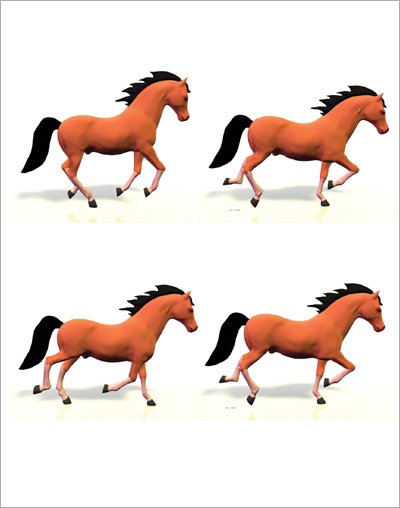Chapter Eight. Animal Motion
Eight Animal Motion

Animals are quite common in animation. Animators often need to bring non-human creatures to life. The anatomy of most four-legged mammals, as well as that of reptiles, dinosaurs, snakes, and insects, is quite different from our primate podiatry. This chapter gives you the essentials you need to animate most of the major types of animals.
Each animal has different ways of moving, depending on the creature's size, shape, and purpose. Small animals tend to move faster than large ones; predators move differently than prey. When animating animals, it is always a good idea to go to the source, so to speak, and get lots of reference for your animation. A trip to the zoo or a good nature documentary can help you understand how a particular animal moves.

Chapter One. Basics of Character Design
- Chapter One. Basics of Character Design
- Approaching Design as an Artist
- Design Styles
- Designing a Character
- Finalizing Your Design
Chapter Two. Modeling Characters
Chapter Three. Rigging Characters
- Chapter Three. Rigging Characters
- Hierarchies and Character Animation
- Facial Rigging
- Mesh Deformation
- Refining Rigs
- Conclusion
Chapter Four. Basics of Animation
- Chapter Four. Basics of Animation
- Understanding Motion
- Animation Interfaces
- The Language of Movement
- Secondary Action
- Conclusion
Chapter Five. Creating Strong Poses
- Chapter Five. Creating Strong Poses
- Posing the Body Naturally
- Creating Appealing Poses
- Animating with Poses
- Conclusion
Chapter Six. Walking and Locomotion
- Chapter Six. Walking and Locomotion
- The Mechanics of Walking
- Animating Walks
- Beyond Walking
- Adding Personality to a Walk
- Transitions
- Conclusion
Chapter Seven. Facial and Dialogue Animation
Chapter Eight. Animal Motion
Chapter Nine. Acting
- Chapter Nine. Acting
- Acting Vs. Animating
- Acting and Story
- Acting Technique
- Acting and the Body
- Other Techniques
- Conclusion
Chapter Ten. Directing and Filmmaking
EAN: 2147483647
Pages: 84
